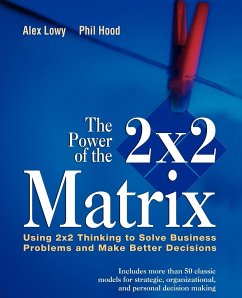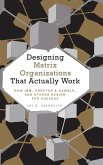Alex Lowy, Phil Hood
The Power of the 2 X 2 Matrix
Using 2 X 2 Thinking to Solve Business Problems and Make Better Decisions
Alex Lowy, Phil Hood
The Power of the 2 X 2 Matrix
Using 2 X 2 Thinking to Solve Business Problems and Make Better Decisions
- Broschiertes Buch
- Merkliste
- Auf die Merkliste
- Bewerten Bewerten
- Teilen
- Produkt teilen
- Produkterinnerung
- Produkterinnerung
The Power of the 2 x 2 Matrix is a gold mine of ideas and tools for the business problem solver. Draw from the book's collection of 56 outstanding frameworks applied by leading business thinkers such as Michael Porter, Stephen Covey, and Igor Ansoff. These tested frameworks will help you tackle the thorniest of issues and learn how to apply 2 x 2 Thinking--the strategic orientation of the most successful and innovative problem solvers.
Andere Kunden interessierten sich auch für
![Designing Matrix Organizations That Actually Work Designing Matrix Organizations That Actually Work]() Jay R GalbraithDesigning Matrix Organizations That Actually Work61,99 €
Jay R GalbraithDesigning Matrix Organizations That Actually Work61,99 €![The Blackwell Handbook of Global Management The Blackwell Handbook of Global Management]() HENRY W LANEThe Blackwell Handbook of Global Management75,99 €
HENRY W LANEThe Blackwell Handbook of Global Management75,99 €![The Behavioral Foundations of Strategic Management The Behavioral Foundations of Strategic Management]() Philip BromileyThe Behavioral Foundations of Strategic Management51,99 €
Philip BromileyThe Behavioral Foundations of Strategic Management51,99 €![The Behavioral Foundations of Strategic Management The Behavioral Foundations of Strategic Management]() Philip BromileyThe Behavioral Foundations of Strategic Management100,99 €
Philip BromileyThe Behavioral Foundations of Strategic Management100,99 €![The Power of Team Building The Power of Team Building]() Harrison SnowThe Power of Team Building58,99 €
Harrison SnowThe Power of Team Building58,99 €![The Blackwell Encyclopedia of Management, Human Resource Management The Blackwell Encyclopedia of Management, Human Resource Management]() SUSAN CARTWRIGHT SThe Blackwell Encyclopedia of Management, Human Resource Management156,99 €
SUSAN CARTWRIGHT SThe Blackwell Encyclopedia of Management, Human Resource Management156,99 €![The Blackwell Encyclopedia of Management, Strategic Management The Blackwell Encyclopedia of Management, Strategic Management]() McgeeThe Blackwell Encyclopedia of Management, Strategic Management141,99 €
McgeeThe Blackwell Encyclopedia of Management, Strategic Management141,99 €-
-
-
The Power of the 2 x 2 Matrix is a gold mine of ideas and tools for the business problem solver. Draw from the book's collection of 56 outstanding frameworks applied by leading business thinkers such as Michael Porter, Stephen Covey, and Igor Ansoff. These tested frameworks will help you tackle the thorniest of issues and learn how to apply 2 x 2 Thinking--the strategic orientation of the most successful and innovative problem solvers.
Hinweis: Dieser Artikel kann nur an eine deutsche Lieferadresse ausgeliefert werden.
Hinweis: Dieser Artikel kann nur an eine deutsche Lieferadresse ausgeliefert werden.
Produktdetails
- Produktdetails
- Verlag: Wiley
- Seitenzahl: 352
- Erscheinungstermin: 26. Oktober 2010
- Englisch
- Abmessung: 235mm x 191mm x 19mm
- Gewicht: 647g
- ISBN-13: 9781118008799
- ISBN-10: 1118008790
- Artikelnr.: 32091230
- Herstellerkennzeichnung
- Libri GmbH
- Europaallee 1
- 36244 Bad Hersfeld
- gpsr@libri.de
- Verlag: Wiley
- Seitenzahl: 352
- Erscheinungstermin: 26. Oktober 2010
- Englisch
- Abmessung: 235mm x 191mm x 19mm
- Gewicht: 647g
- ISBN-13: 9781118008799
- ISBN-10: 1118008790
- Artikelnr.: 32091230
- Herstellerkennzeichnung
- Libri GmbH
- Europaallee 1
- 36244 Bad Hersfeld
- gpsr@libri.de
Alex Lowy is an internationally recognized thought leader specializing in the creation of innovative work, learning, and information systems. He is the cofounder and past president of Digital 4Sight, a global technology think tank and strategy consulting firm with headquarters in Toronto, Canada. He has coauthored two best-selling business books, Digital Capital: Harnessing the Power of Business Webs (2000) and Blueprint to the Digital Economy (1998) with Don Tapscott and David Ticoll. In 2003, he formed the Transcend Strategy Group. Phil Hood is one of Silicon Valley's most thoughtful voices on the development and use of multimedia and pervasive computing technologies. He is the former executive editor of NewMedia magazine, and a contributing columnist to Wired. For two years he was chief executive officer of Digital 4Sight. He is a senior consulting associate to Stanford Research International (SRI), and a partner with Alex Lowy in the Transcend Strategy Group.
Foreword xiii
James H. Gilmore and B. Joseph Pine ii
Acknowledgments xvii
The Authors xix
Introduction 1
Part One: 2 x 2 Thinking
1 The DNA of Great Problem Solving 9
2 Form, Method, and Mastery: 2 × 2 Thinking as Dialectical Process 24
3 The Eight Archetypal Dilemmas 37
Part Two: 2 x 2 Practice
4 Designing 2 × 2 Matrices: Making Intuition Explicit 61
5 2 × 2 Thinking in Action: Fujitsu FTXS Tackles Level 2 Dilemmas 69
Part Three: 2 x 2 Frameworks Inventory
6 Strategic Frameworks 91
Beyond Customer Led 95
Discontinuity and the Life Cycle 99
Customer as Value Manager 105
Customer Value Analysis 107
Scenarios 115
Gartner Magic Quadrant 121
Portfolio Analysis 125
Problems and Solutions 127
Dialectical SWOT Analysis: Strengths, Weaknesses, Opportunities, and
Threats 129
Market Tipping 131
Corporate Strategy 134
Generic Strategy 139
E-Business Opportunity Matrix 144
Global Product Planning 146
Generic Network Strategy 148
Mass Customization: The Four Approaches 151
Attentionscape 156
Managing Customer Loyalty 158
Likelihood to Buy 161
Revenue and Profitability 163
BCG: Product Portfolio Matrix 169
Impact-Uncertainty Matrix 173
Entrance and Exit Strategies 177
7 Organizational Frameworks 180
Good to Great Matrix of Creative Discipline 184
Employee Motivation 188
Alliance Drivers 190
Team Types 193
Situational Leadership 195
The Four Power Players in Knowledge Organizations 199
T-Group Leadership 202
Seci 204
Human Capital 210
Differentiation and Integration 215
Means and Ends 219
The Change Grid 221
Learning and Change 223
Similarities and Differences 225
The Four Realms of Experience 228
Make versus Buy 233
Four Square Model 236
Product and Supply Chain Architecture 238
Telematics Framework 244
The Virtue Matrix 246
8 Individual Frameworks 250
Johari Window 255
Myers-Briggs Type Indicator 261
Learning Styles Inventory 267
I'm OK, You're OK: The Four Life Positions 269
Conflict Mode 271
Social Styles 274
Getting It Right 279
Leadership Coaching 281
Career Transitioning 283
Prisoner's Dilemma 286
Urgency and Importance 290
Influence and Concern 292
Notes 295
Index 303
James H. Gilmore and B. Joseph Pine ii
Acknowledgments xvii
The Authors xix
Introduction 1
Part One: 2 x 2 Thinking
1 The DNA of Great Problem Solving 9
2 Form, Method, and Mastery: 2 × 2 Thinking as Dialectical Process 24
3 The Eight Archetypal Dilemmas 37
Part Two: 2 x 2 Practice
4 Designing 2 × 2 Matrices: Making Intuition Explicit 61
5 2 × 2 Thinking in Action: Fujitsu FTXS Tackles Level 2 Dilemmas 69
Part Three: 2 x 2 Frameworks Inventory
6 Strategic Frameworks 91
Beyond Customer Led 95
Discontinuity and the Life Cycle 99
Customer as Value Manager 105
Customer Value Analysis 107
Scenarios 115
Gartner Magic Quadrant 121
Portfolio Analysis 125
Problems and Solutions 127
Dialectical SWOT Analysis: Strengths, Weaknesses, Opportunities, and
Threats 129
Market Tipping 131
Corporate Strategy 134
Generic Strategy 139
E-Business Opportunity Matrix 144
Global Product Planning 146
Generic Network Strategy 148
Mass Customization: The Four Approaches 151
Attentionscape 156
Managing Customer Loyalty 158
Likelihood to Buy 161
Revenue and Profitability 163
BCG: Product Portfolio Matrix 169
Impact-Uncertainty Matrix 173
Entrance and Exit Strategies 177
7 Organizational Frameworks 180
Good to Great Matrix of Creative Discipline 184
Employee Motivation 188
Alliance Drivers 190
Team Types 193
Situational Leadership 195
The Four Power Players in Knowledge Organizations 199
T-Group Leadership 202
Seci 204
Human Capital 210
Differentiation and Integration 215
Means and Ends 219
The Change Grid 221
Learning and Change 223
Similarities and Differences 225
The Four Realms of Experience 228
Make versus Buy 233
Four Square Model 236
Product and Supply Chain Architecture 238
Telematics Framework 244
The Virtue Matrix 246
8 Individual Frameworks 250
Johari Window 255
Myers-Briggs Type Indicator 261
Learning Styles Inventory 267
I'm OK, You're OK: The Four Life Positions 269
Conflict Mode 271
Social Styles 274
Getting It Right 279
Leadership Coaching 281
Career Transitioning 283
Prisoner's Dilemma 286
Urgency and Importance 290
Influence and Concern 292
Notes 295
Index 303
Foreword xiii
James H. Gilmore and B. Joseph Pine ii
Acknowledgments xvii
The Authors xix
Introduction 1
Part One: 2 x 2 Thinking
1 The DNA of Great Problem Solving 9
2 Form, Method, and Mastery: 2 × 2 Thinking as Dialectical Process 24
3 The Eight Archetypal Dilemmas 37
Part Two: 2 x 2 Practice
4 Designing 2 × 2 Matrices: Making Intuition Explicit 61
5 2 × 2 Thinking in Action: Fujitsu FTXS Tackles Level 2 Dilemmas 69
Part Three: 2 x 2 Frameworks Inventory
6 Strategic Frameworks 91
Beyond Customer Led 95
Discontinuity and the Life Cycle 99
Customer as Value Manager 105
Customer Value Analysis 107
Scenarios 115
Gartner Magic Quadrant 121
Portfolio Analysis 125
Problems and Solutions 127
Dialectical SWOT Analysis: Strengths, Weaknesses, Opportunities, and
Threats 129
Market Tipping 131
Corporate Strategy 134
Generic Strategy 139
E-Business Opportunity Matrix 144
Global Product Planning 146
Generic Network Strategy 148
Mass Customization: The Four Approaches 151
Attentionscape 156
Managing Customer Loyalty 158
Likelihood to Buy 161
Revenue and Profitability 163
BCG: Product Portfolio Matrix 169
Impact-Uncertainty Matrix 173
Entrance and Exit Strategies 177
7 Organizational Frameworks 180
Good to Great Matrix of Creative Discipline 184
Employee Motivation 188
Alliance Drivers 190
Team Types 193
Situational Leadership 195
The Four Power Players in Knowledge Organizations 199
T-Group Leadership 202
Seci 204
Human Capital 210
Differentiation and Integration 215
Means and Ends 219
The Change Grid 221
Learning and Change 223
Similarities and Differences 225
The Four Realms of Experience 228
Make versus Buy 233
Four Square Model 236
Product and Supply Chain Architecture 238
Telematics Framework 244
The Virtue Matrix 246
8 Individual Frameworks 250
Johari Window 255
Myers-Briggs Type Indicator 261
Learning Styles Inventory 267
I'm OK, You're OK: The Four Life Positions 269
Conflict Mode 271
Social Styles 274
Getting It Right 279
Leadership Coaching 281
Career Transitioning 283
Prisoner's Dilemma 286
Urgency and Importance 290
Influence and Concern 292
Notes 295
Index 303
James H. Gilmore and B. Joseph Pine ii
Acknowledgments xvii
The Authors xix
Introduction 1
Part One: 2 x 2 Thinking
1 The DNA of Great Problem Solving 9
2 Form, Method, and Mastery: 2 × 2 Thinking as Dialectical Process 24
3 The Eight Archetypal Dilemmas 37
Part Two: 2 x 2 Practice
4 Designing 2 × 2 Matrices: Making Intuition Explicit 61
5 2 × 2 Thinking in Action: Fujitsu FTXS Tackles Level 2 Dilemmas 69
Part Three: 2 x 2 Frameworks Inventory
6 Strategic Frameworks 91
Beyond Customer Led 95
Discontinuity and the Life Cycle 99
Customer as Value Manager 105
Customer Value Analysis 107
Scenarios 115
Gartner Magic Quadrant 121
Portfolio Analysis 125
Problems and Solutions 127
Dialectical SWOT Analysis: Strengths, Weaknesses, Opportunities, and
Threats 129
Market Tipping 131
Corporate Strategy 134
Generic Strategy 139
E-Business Opportunity Matrix 144
Global Product Planning 146
Generic Network Strategy 148
Mass Customization: The Four Approaches 151
Attentionscape 156
Managing Customer Loyalty 158
Likelihood to Buy 161
Revenue and Profitability 163
BCG: Product Portfolio Matrix 169
Impact-Uncertainty Matrix 173
Entrance and Exit Strategies 177
7 Organizational Frameworks 180
Good to Great Matrix of Creative Discipline 184
Employee Motivation 188
Alliance Drivers 190
Team Types 193
Situational Leadership 195
The Four Power Players in Knowledge Organizations 199
T-Group Leadership 202
Seci 204
Human Capital 210
Differentiation and Integration 215
Means and Ends 219
The Change Grid 221
Learning and Change 223
Similarities and Differences 225
The Four Realms of Experience 228
Make versus Buy 233
Four Square Model 236
Product and Supply Chain Architecture 238
Telematics Framework 244
The Virtue Matrix 246
8 Individual Frameworks 250
Johari Window 255
Myers-Briggs Type Indicator 261
Learning Styles Inventory 267
I'm OK, You're OK: The Four Life Positions 269
Conflict Mode 271
Social Styles 274
Getting It Right 279
Leadership Coaching 281
Career Transitioning 283
Prisoner's Dilemma 286
Urgency and Importance 290
Influence and Concern 292
Notes 295
Index 303








